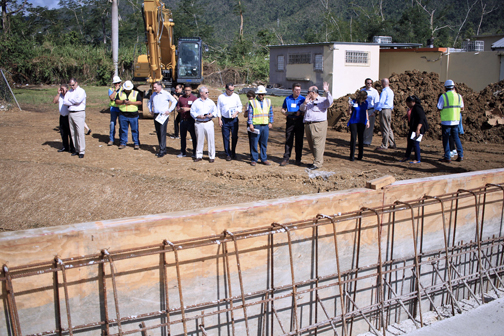Hurricane Maria’s blow on P.R’s. infrastructure ‘example’ of need to invest


The multidisciplinary group toured the Bairoa bridge in Caguas.
The catastrophic damages Hurricane María dealt to Puerto Rico’s infrastructure — and its state of disrepair six months later — is “an example of what is happening throughout the country due to a lack of pro-active investment in the infrastructure to create more resistant energy systems, bridges, roads and aqueducts.”
So said Paul Horgan, the head of the Commercial Insurance division of Zurich North America, which hosted a multidisciplinary group discussion Thursday on what is needed to rebuild Puerto Rico’s infrastructure and to evaluate what new ideas can be adapted to be used in the reconstruction of the United States infrastructure.
The roundtable included representatives of the fields of engineering, sustainability, private investments, government, construction and urban planning.
“Our objective is to facilitate a conversation about the complex challenges that Puerto Rico is facing, with emphasis on a reconstruction that follows a standard that will better resist future catastrophes,” said Horgan.
The event coincided with Zurich’s publication of a document titled “Rebuilding Infrastructure: The Need for Sustainable and Resilient Solutions,” which emphasizes the need of developing sustainable planning and resistant construction, in a time where serious atmospheric events increase in strength and frequency.
“After a disaster, there is little time to think beyond recovery,” the document stated. “In reality, the time should be spent beforehand to make sure that the lights stay on during the next disaster.”
The two-hour discussion, which took place before representatives of local businesses, civic groups and the government, and it focused on the following:
- Rebuilding beyond recovery after a disaster;
- The condition of PR’s infrastructure before and after the hurricanes; and,
- A sustainable infrastructure and how to build it following resistance standards and how to pay for it.
Recent studies show that every dollar spent in building reconstruction or improvements that meet stricter building codes results in the savings of four dollars that would have been used to repair damages. Investing in building a more resistant infrastructure could result a similar yield, the experts said.
The group traveled to Caguas to observe the reconstruction of a bridge by the Federal Emergency Management Agency, and the rebuilding of an electric energy plant in Monacillos, San Juan led by the Puerto Rico Electric Power Authority.
“The state of Puerto Rico’s infrastructure after the hurricanes and the decadent state of the infrastructure in other parts of the United States not only affects the quality of life of every individual, but also has a great economic impact in the everyday operations of businesses,” added Horgan, who is a member of the Infrastructure Executive Council of the Bipartisan Policy Center and a member of the Partnership for New York City.
In May 2018, Zurich will sponsor “Infrastructure Week,” when national organizations and individuals will join to draw attention to the matter of outdated infrastructure and to motivate national leadership to invest in the projects, technology and policies needed to make the United States a “competitive, prosperous and safe nation,” the company stated.
“The insurance industry has a key role in the search for solutions for the rebuilding of the infrastructure,” said Horgan.
“We won’t be able to truly improve the infrastructure of Puerto Rico and of the United States, in general, unless we promote the collaboration between all the interested parties and maintain conversations like the one we are having today,” he concluded.














